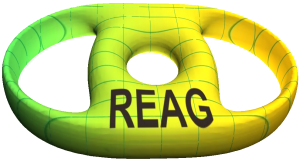The (strict) nearly Kähler homogeneous Riemannian manifolds of dimension six have been classified by Butruille. Indeed, these are the round sphere $\mathsf{S}^{6}$, the flag manifold $\mathsf{F}(\mathbb{C}^{3})$, the complex projective space $\mathbb{C}\mathsf{P}^{3}$ and $\mathsf{S}^{3}\times\mathsf{S}^{3}$. These spaces are endowed with a naturally reductive structure, which allows us to understand their geometric properties by means of Lie algebras. In this talk, I will describe a joint work with Alberto Rodríguez-Vázquez (KU Leuven) in which we classify the totally geodesic submanifolds of the aforementioned spaces. To this end, we will develop the algebraic framework needed to attack the problem, and later on we will exhibit the examples that appear in each case, as well as their relationship with the ambient almost complex structure.
Geometry day
Santiago de Compostela - 11 April 2024
Venue
Facultade de Matemáticas (Aula 10), Universidade de Santiago de CompostelaProgram
-
-
In this talk, we present a characterization of minimal Lagrangian submanifolds in the nearly Kähler manifold (NK) $G\times G$. First, we review the construction of an NK manifold on the Lie group product $G\times G$, where G is a Lie group with a bi-invariant metric. This construction was proposed by K. Sekigawa to E. Abenna and S. Garbiero. Second, we extend the concept of angle functions proposed by B. Dioos, L. Vrancken, and X. Wang in the case of $\mathbb{S}^{3}\times \mathbb{S}^{3}$. Finally, we prove that a Lagrangian manifold is minimal if and only if the sum of its angle functions is constant.
- 17:00 - 17:30 Break
-
A translation surface in the Euclidean space $\mathbb{R}^3$ is a surface given by the sum of two curves in $\mathbb{R}^3$, i.e., a surface parameterized as $X(s,t) = \alpha(t) + \beta(t)$. In this talk, using the Lie group structures for the standard 3-sphere and the hyperbolic 3-space, translation surfaces will be introduced as a product of two curves in the corresponding ambient space. In this context, existence and rigidity results for minimal and constant mean curvature translation surfaces will be considered.
-
An isometric action on a Riemannian manifold is said to be of cohomogeneity one if its regular orbits are hypersurfaces. Such actions are a useful tool for the construction of various geometric structures, and also interesting from the viewpoint of submanifold geometry. The classification of cohomogeneity one actions on Euclidean and hyperbolic spaces follows from classical work of Segre, Levi-Civita and Cartan on isoparametric hypersurfaces. However, obtaining similar results for more general symmetric spaces has proven to be a difficult problem, and is still an active topic of research with several recent contributions.
In this talk, I will report on ongoing work with Hiroshi Tamaru where we study cohomogeneity one actions on products of Riemannian manifolds. Using this, we are able to classify homogeneous codimension one foliations on (simply connected) symmetric spaces.
Organizers
- Miguel Domínguez Vázquez, CITMAga - Universidade de Santiago de Compostela.
Sponsors
- Grant PID2022-138988NB-I00 funded by MICIU/AEI/10.13039/501100011033 and by ERDF
- Project ED431F 2020/04, Xunta de Galicia, Spain
- Centro de Investigación e Tecnoloxía Matemática de Galicia (CITMAga), Spain
- Red Española de Análisis Geométrico



